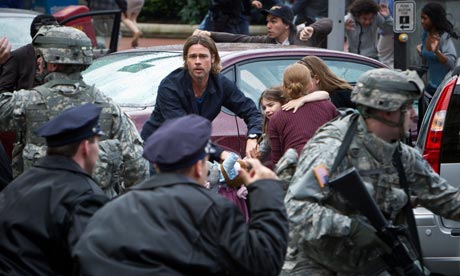
It's a cliché to say that Author W does for Subject X what Author Y did for Subject Z. But it was one I found unavoidable when I turned the final page of Benjamin Percy's excellent Red Moon, released last week.
For it has to be said that Benjamin Percy does for werewolves what Justin Cronin did for vampires and, before that, Max Brooks did for zombies. This century the monsters of old have been taken out of the shadows. Where once a single, terrifying creature sparked supernatural terror, now monsters have become the product of science, of viruses, of very human meddling. They have multiplied and been recast from the night into bright sunlight on a global scale. The horror is now the prospect of monsters supplanting humanity … but does that make them any more scary?
Vampires, werewolves and the revenant dead have been the unholy trinity at the heart of modern horror since the days of folk tale. But their journey from archetype to ubiquity has, I feel, been brought to an almost inevitable conclusion.
Red Moon posits a world where werewolves – lycans, in the book – exist alongside mankind. But they aren't supernatural creatures, rather the unfortunate victims of a prion-based, BSE-style infection. Percy's werewolves are analogues for various bogeyman that have haunted Conservative America for decades – Black Power activists, Islamists, Aids carriers. They even have their own Palestine-like country in inhospitable land between Finland and Russia, where US troops maintain martial law and American power companies mine uranium. The lycans can transform at will, but their animal nature is largely kept in check by regular doses of soporific medication called Lupex. But now militant lycans are determined to take the fight for civil liberties direct to the heart of America …
Percy writes in an assured, cool, sexy style: there are shocks aplenty and suspense in spades, but no scares in the traditional horror novel sense. By situating his werewolves firmly in a post-9/11 world, he takes the old horror staple out of the shadows and shines a very contemporary spotlight on it.
This is precisely what Max Brooks did with his 2006 novel World War Z. This take on the zombie apocalypse dropped the standard narrative of a handful of plucky survivors waking up to find the world gone to hell in a handcart overnight. Using a style of "eyewitness interviews" popularised by documentary television, Brooks described a pandemic sweeping the world from a Patient Zero in China, informed by real-world international crises. Thus, as well as people running away from shambling animated corpses, we also get the military and political response to the apocalyptic event. The terror of Brooks's novel – which, sadly, doesn't look as though it's going to be replicated in the upcoming Brad Pitt movie version – comes from how horribly real it all feels.
The vampires in Justin Cronin's 2010 novel The Passage are the result of a military experiment on a dozen death row inmates, who are genetically modified to become super-soldiers. After detailing the initial outbreak as the blood-hungry and highly infectious dozen escape and spread the virus, Cronin jumps forward almost a century to a ravaged America where scattered colonies struggle to hold out against the hordes of vampires. Perhaps the most traditional horror of the trio, with shades of Stephen King, The Passage nonetheless removes vampirism from the realm of the supernatural and portrays it as science fiction.
The old folk tales of vampires, werewolves and zombies were reanimated in 19th-century literature. Bram Stoker's Dracula, of course, is the most famous vampire ever. I raised the idea on Twitter (and was largely shouted down) that Mary Shelley's Frankenstein was the first zombie. The rampaging, infectious undead of latter years are largely a George Romero invention but I think Frankenstein's monster, made from the reanimated parts of corpses, is a sufficient literary base from which the unquiet dead later evolved. There doesn't seem to be a quintessential werewolf novel from the period, though there were many – among them Wagner the Wehr-Wolf by GWM Reynolds (1847) and The Wolf Leader by Alexandre Dumas a decade later.
Dracula, Frankenstein's Monster and the Wolf-Man reached the silver screen in the 1930s and were embedded in the public consciousness. The trio have appeared in everything from Scooby-Doo cartoons to Abbott and Costello movies, and today are standard Halloween costumes for children who have never read the source material nor watched the classic movies.
Max Brooks, Justin Cronin and now Benjamin Percy have tested these tropes to destruction, expanding the singular prescences of folk tales into world-threatening hordes born of mankind's meddling with science. And, as such, I feel they have effectively taken the werewolf, the vampire and the zombie/revenant to their natural, epic, widescreen conclusion.
Which raises the question: When the old monsters have become so big that they have outgrown the terror of a snapped twig in a dark forest, from where are we now going to get our literary chills? Any thoughts?

